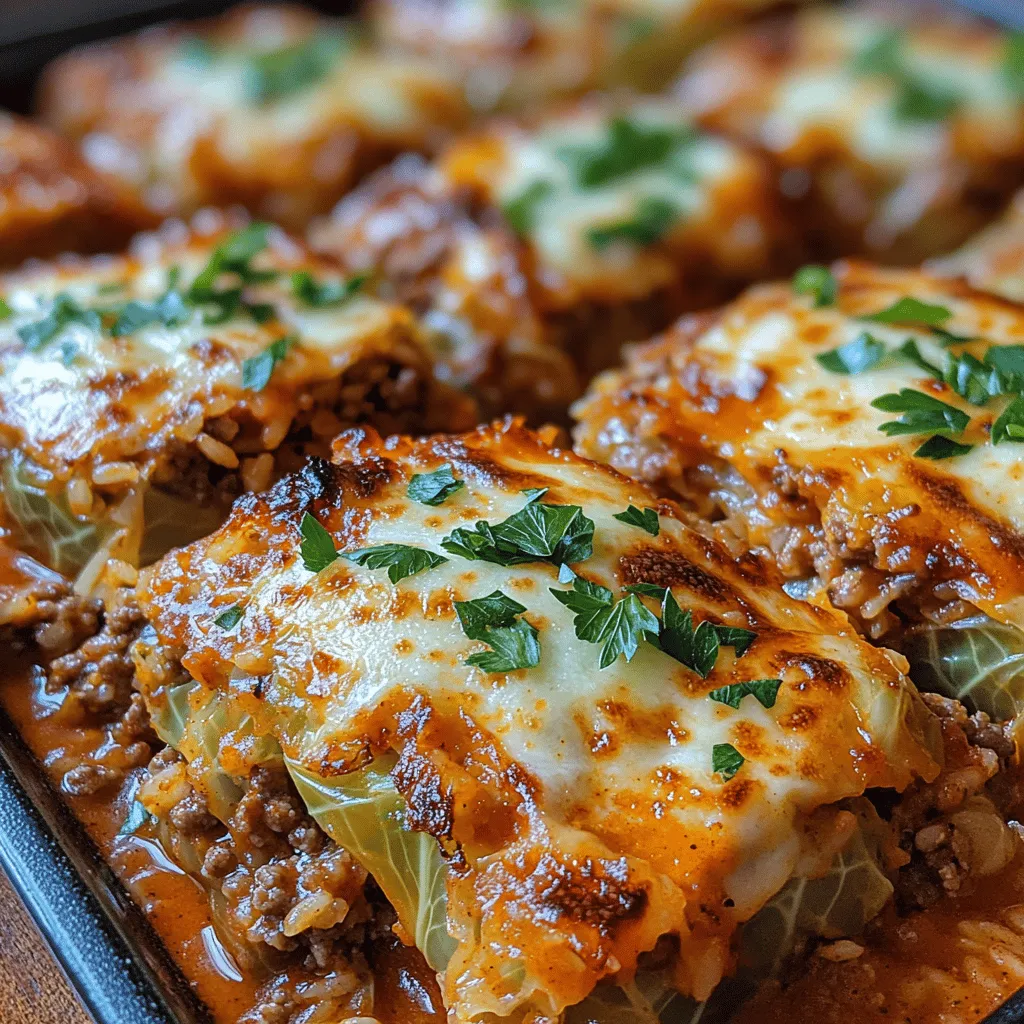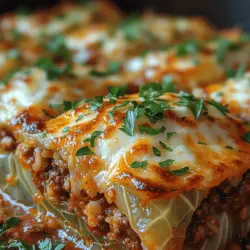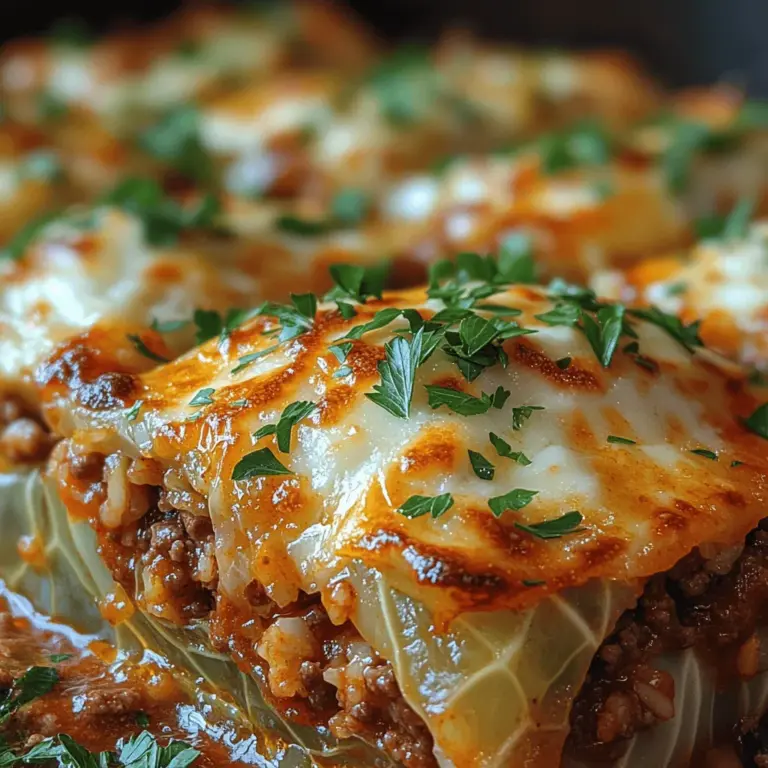Cabbage has long been a staple in many cultures around the globe, revered not only for its versatility but also for its health benefits. One remarkable way to enjoy cabbage is through a hearty dish known as Savory Stuffed Cabbage Casserole. This delightful recipe combines the wholesome goodness of cabbage with a rich filling of ground beef, rice, and a blend of savory spices, resulting in a comforting meal that warms the heart and soul. Ideal for family gatherings or weeknight dinners, this casserole transforms the humble cabbage into an impressive culinary experience that is both satisfying and nutritious.
The beauty of Savory Stuffed Cabbage Casserole lies in its simplicity and flavor. It caters to both novice cooks and seasoned chefs, making it an accessible recipe for anyone looking to add a delicious twist to their dinner repertoire. With clear, step-by-step instructions, you’ll find that preparing this dish is not just easy but also incredibly rewarding. As you embark on this culinary journey, let’s first delve into the nutritional benefits of cabbage and the other key ingredients that make this casserole a standout.
Understanding the Nutritional Benefits of Cabbage
Cabbage as a Nutrient Powerhouse
Cabbage is often overlooked in the vegetable aisle, yet it holds a treasure trove of nutritional benefits. Low in calories but high in fiber, cabbage is an excellent choice for those looking to maintain a healthy diet. A single cup of chopped green cabbage contains only about 22 calories, making it a guilt-free addition to your meals.
Moreover, cabbage is rich in vitamins K and C. Vitamin K plays a crucial role in bone health and blood clotting, while vitamin C is a well-known antioxidant that boosts the immune system and promotes skin health. Additionally, cabbage contains antioxidants like polyphenols and sulfur compounds, which contribute to its anti-inflammatory properties.
The Role of Ground Meat in a Balanced Diet
The filling for our Savory Stuffed Cabbage Casserole typically features ground beef, but you can easily substitute it with ground turkey or chicken for a lighter option. Ground beef provides a robust source of protein, essential for building and repairing tissues in the body. Depending on the cut, it can also offer varying levels of fat, so it’s important to choose lean cuts when possible to keep your dish on the healthier side.
When comparing beef to turkey, ground turkey is often lower in calories and fat, making it a popular choice for those seeking to cut back on red meat. However, beef brings a rich flavor profile that many enjoy, offering a savory depth that complements the cabbage beautifully. Regardless of your choice, incorporating ground meat into your diet can provide essential nutrients, including iron, zinc, and B vitamins.
Ingredients Overview
An In-Depth Look at the Key Ingredients
To make the Savory Stuffed Cabbage Casserole, you’ll need a handful of key ingredients. Each plays a crucial role in not only the flavor but also the nutritional value of the dish.
Green Cabbage: Selection and Storage Tips
Choosing the right cabbage is the first step to ensuring a successful casserole. Look for heads that are firm and dense, with tightly packed leaves. The outer leaves should be vibrant and free from blemishes or discoloration. Once purchased, store cabbage in the refrigerator, where it can stay fresh for up to two weeks.
When preparing the casserole, you’ll need to separate the leaves, which can be done through blanching. This technique softens the leaves, making them pliable enough to roll without tearing. Adequate handling is key, as you want to maintain their integrity for the filling.
Ground Beef or Turkey: Understanding Flavor Profiles
As mentioned, you can choose between ground beef or turkey based on your dietary preferences. Ground beef, particularly lean varieties, offers a rich flavor that enhances the overall taste of the casserole. On the other hand, ground turkey is milder and may require more seasoning to achieve a similar depth of flavor. Regardless of your choice, ensure the meat is fresh and of high quality, as this will significantly affect the final dish.
Rice: White vs. Brown Rice – Nutritional Impact
Rice is a vital part of the filling, providing texture and bulk. While white rice is commonly used, brown rice is a healthier alternative, offering more fiber, vitamins, and minerals. Brown rice takes longer to cook, but its nutty flavor and chewy texture can elevate the dish. If using white rice, opt for long-grain varieties for better fluffiness. You can also prepare the rice ahead of time, making the assembly process quicker and easier.
Tomato Products: How They Enhance Flavor and Nutrition
Tomato products, such as tomato sauce or diced tomatoes, are essential in this casserole. They add moisture, flavor, and a hint of acidity that balances the richness of the meat. Additionally, tomatoes are a great source of vitamins C and K, as well as potassium. When selecting tomato products, look for those without added sugars or preservatives to keep your dish wholesome.
Seasonings: The Importance of Worcestershire Sauce and Italian Seasoning
Seasonings play a critical role in bringing all the flavors together. Worcestershire sauce adds a savory umami kick, enhancing the meat’s taste and depth. Italian seasoning, typically a blend of herbs such as basil, oregano, and thyme, brings a warm and aromatic quality to the casserole. Feel free to adjust these seasonings according to your palate; the goal is to create a filling that is both flavorful and comforting.
Step-by-Step Preparation of Savory Stuffed Cabbage Casserole
Now that we’ve covered the nutritional benefits and key ingredients, it’s time to dive into the preparation of your Savory Stuffed Cabbage Casserole. The initial steps will involve preparing the cabbage and creating the flavorful filling.
Preparing the Cabbage for Cooking
The first step in making your casserole is preparing the cabbage. This involves blanching the leaves to soften them, making them easier to roll around the filling.
Techniques for Blanching Cabbage Leaves
1. Select a Large Pot: Fill a large pot with water and bring it to a boil over high heat. Ensure there’s enough water to fully submerge the cabbage head.
2. Prepare the Cabbage: Carefully remove the core of the cabbage with a sharp knife. This will help the leaves separate more easily.
3. Blanch the Leaves: Once the water is boiling, gently place the whole cabbage into the pot. Blanch for about 2-3 minutes, or until the outer leaves start to soften. Use tongs to carefully remove the cabbage, allowing it to cool slightly.
4. Separate the Leaves: Once cool enough to handle, start peeling away the outer leaves. You can return the cabbage to the pot for another round of blanching if additional leaves are still too firm.
5. Set Aside: Place the blanched leaves on a clean kitchen towel or a large plate to drain and cool completely.
Tips for Handling and Rolling Cabbage Leaves
When it comes to rolling the cabbage leaves, it’s important to handle them gently to avoid tearing. Lay each leaf on a flat surface, and trim any thick stems to make rolling easier. Place a generous spoonful of the filling at the base of the leaf, fold in the sides, and then roll it up tightly, similar to a burrito.
Once you’ve rolled all the leaves, you can set them aside while you prepare the filling.
Creating the Flavorful Filling
With the cabbage prepared, it’s time to make the delicious filling that will elevate your casserole.
1. Cook the Rice: If using brown rice, start by cooking it according to package instructions. For white rice, you can prepare it in advance or simultaneously while you prepare the meat.
2. Sauté the Ground Meat: In a large skillet, heat a tablespoon of oil over medium heat. Add the ground meat, breaking it apart as it cooks. Season with salt and pepper, and allow it to brown evenly.
3. Add Aromatics: Once the meat is browned, add finely chopped onions and minced garlic to the skillet. Sauté until the onions are translucent and fragrant, about 3-5 minutes.
4. Incorporate Tomato Products: Stir in your choice of tomato sauce or diced tomatoes, along with Worcestershire sauce and Italian seasoning. Allow the mixture to simmer for about 5 minutes, letting the flavors meld together.
5. Combine with Rice: In a large mixing bowl, combine the cooked rice with the meat mixture. This step ensures that every bite of your casserole is packed with flavor.
6. Adjust Seasoning: Taste the filling and adjust the seasoning as necessary. Feel free to add more herbs, spices, or salt to suit your preference.
As you assemble the casserole, the tantalizing aroma of the filling will fill your kitchen, hinting at the delicious meal that awaits.
This initial stage of preparing your Savory Stuffed Cabbage Casserole sets the foundation for a dish that is not only nourishing but also brings the family together around the dinner table. In the next part of this article, we will explore the final steps of assembling and baking the casserole, ensuring that every layer of flavor is perfectly balanced.

The Importance of Sautéing Onions and Garlic
Sautéing onions and garlic is a crucial step in creating a flavor foundation for your savory stuffed cabbage casserole. When you sauté onions, they caramelize, releasing their natural sugars and creating a sweet, rich flavor. Garlic, when cooked, transforms from sharp and pungent to a mellow, aromatic addition that enhances the overall taste profile of the dish.
Start by heating a tablespoon of olive oil in a large skillet over medium heat. Add finely chopped onions and cook them until they become translucent, usually around 5 to 7 minutes. Next, add minced garlic and sauté for an additional minute, taking care not to burn it, as burnt garlic can impart a bitter flavor. This aromatic base will not only enhance the savory notes of your meat but also add depth to the entire casserole.
Tips for Achieving Perfectly Browned Meat
Browning the meat is an essential component of building flavor in your casserole. The Maillard reaction occurs during the browning process, creating a rich, complex taste. Here are some tips to ensure your meat is perfectly browned:
1. Choose the Right Pan: Use a heavy-bottomed skillet that retains heat well, allowing for even cooking. Cast iron or stainless steel pans are excellent choices.
2. Don’t Overcrowd the Pan: If you add too much meat at once, it will steam rather than brown. Cook in batches if necessary, ensuring each piece has enough space to develop a nice crust.
3. Let It Sit: After adding the meat to the pan, allow it to sit undisturbed for a few minutes before stirring. This helps to create a nice sear.
4. Season Well: Season the meat with salt and pepper before adding it to the pan. This enhances the browning and helps to build flavor from the start.
Combining Ingredients: Ensuring a Balanced Flavor Profile
Once you have sautéed your onions and garlic and browned your meat, it’s time to combine the ingredients. The key to a balanced flavor profile lies in the right mix of spices, herbs, and other components.
For your stuffed cabbage casserole, consider adding cooked rice, diced tomatoes, and fresh herbs like parsley or dill. The rice will absorb flavors while providing a hearty texture, while tomatoes add acidity and sweetness that balance the richness of the meat. Taste your mixture before assembling the casserole; adjust seasoning with salt, pepper, or additional herbs to ensure a harmonious flavor.
Assembling the Casserole
Layering Techniques for Even Cooking
Assembling your casserole correctly is vital for achieving even cooking and flavor distribution. Start by preheating your oven to 350°F (175°C).
1. Base Layer: Spread a thin layer of tomato sauce or chopped tomatoes on the bottom of your baking dish. This prevents sticking and adds moisture to the casserole.
2. Cabbage Layer: Place a layer of cabbage leaves over the sauce. This serves as a barrier, helping to keep the filling moist while it cooks.
3. Filling Layer: Spoon the meat and rice mixture onto the cabbage, distributing it evenly. Use a spatula to flatten the mixture slightly, ensuring consistent cooking.
4. Repeat: Continue layering cabbage, filling, and sauce until all ingredients are used, finishing with a layer of sauce on top.
Proper Rolling Methods for Stuffed Cabbage
If you decide to roll the cabbage leaves around the filling instead of layering, proper rolling techniques are essential for keeping the filling intact during cooking.
1. Prepare the Leaves: Blanch cabbage leaves in boiling water for about 2-3 minutes until they are pliable. Drain and cool them before rolling.
2. Fill and Roll: Place about 2 tablespoons of filling at the base of each leaf. Fold in the sides and roll it up tightly, starting from the base towards the tip. This technique helps to contain the filling while allowing the flavors to meld.
3. Arrange in Dish: Place the rolled cabbage leaves seam side down in the baking dish. Layer them snugly to prevent them from unrolling during baking.
Ensuring a Visually Appealing Presentation
Presentation is key when serving a casserole. After baking, let it rest for about 10-15 minutes before cutting into it; this allows the layers to set. For a visually appealing presentation:
– Garnish: Top with freshly chopped parsley or dill before serving. This adds a pop of color and freshness.
– Serve in Style: Use a large spoon to serve generous portions, ensuring each plate includes layers of cabbage, filling, and sauce for a well-rounded dish.
Baking the Casserole to Perfection
Understanding Baking Temperatures and Times
Baking the casserole correctly is crucial for achieving a tender texture and fully developed flavors. For your savory stuffed cabbage casserole, bake it at 350°F (175°C) for approximately 45-60 minutes. The goal is for the flavors to meld and for the cabbage to become tender.
The Science Behind Covering vs. Uncovering During Baking
Covering your casserole with aluminum foil for the first part of the baking process helps to trap moisture, preventing the dish from drying out. Remove the foil during the last 15-20 minutes to allow the top to brown and become slightly crispy. This balance of covered and uncovered baking ensures a moist filling with a deliciously textured topping.
Tips for Checking Doneness: What to Look For
To check if your casserole is done, look for bubbling sauce around the edges and tender cabbage leaves. Insert a knife into the center; it should slide in easily without resistance. Additionally, you can use a meat thermometer to ensure the internal temperature has reached at least 160°F (70°C) for the meat.
Cheese as the Finishing Touch
The Role of Mozzarella Cheese in Flavor and Texture
Adding cheese to your casserole adds a creamy texture and enhances the overall flavor. Mozzarella cheese is an excellent choice because it melts beautifully, creating a gooey, comforting layer on top of your casserole.
Sprinkle shredded mozzarella over the casserole during the last 10 minutes of baking. This will allow it to melt and form a golden, bubbly crust that adds both flavor and visual appeal.
Exploring Cheese Alternatives for Varied Tastes
If you’re looking to switch things up, consider using other cheeses. Cheddar adds sharpness, while Monterey Jack provides a mild, creamy flavor. For a more gourmet touch, try Gruyère or Fontina, which melt well and bring a nutty flavor to the dish. For a dairy-free option, use plant-based cheeses that melt well, ensuring everyone can enjoy the casserole.
Serving Suggestions and Pairing Ideas
Best Side Dishes to Complement Your Casserole
A savory stuffed cabbage casserole is hearty enough to stand on its own, but pairing it with complementary side dishes can elevate your meal.
– Fresh Salads and Their Benefits: A crisp green salad with a tangy vinaigrette can provide a refreshing contrast to the richness of the casserole. Consider mixing arugula, spinach, and cherry tomatoes with a lemon vinaigrette for a bright, zesty side.
– Bread Options: Serve with crusty loaves or soft rolls to soak up the delicious sauce. A slice of warm, homemade bread can enhance the meal, making it even more comforting.
The Importance of Garnishing
Garnishing your casserole enhances both flavor and visual appeal.
– Fresh Parsley: Chopped parsley adds a burst of freshness and color, making the dish more inviting. Sprinkle it generously over the top before serving.
– Other Herb Options for a Twist: Experiment with other herbs like dill or basil for a unique twist on flavor. These herbs can complement the cabbage and meat beautifully, providing a fresh finish to the dish.
Conclusion
Savory stuffed cabbage casserole is more than just a meal; it’s a delightful experience that brings comfort and warmth to the dining table. With its rich flavors and wholesome ingredients, this casserole is sure to become a family favorite, providing nourishment and satisfaction in every bite. Whether enjoyed on a busy weeknight or served at a gathering, this dish celebrates the simplicity of cooking while allowing you to indulge in a hearty, delightful meal. The thoughtful combination of sautéed onions, browned meat, and layered ingredients creates a flavor-packed dish that is as visually appealing as it is delicious. So gather your loved ones, whip up this savory casserole, and enjoy the comforting goodness that comes with every forkful.

